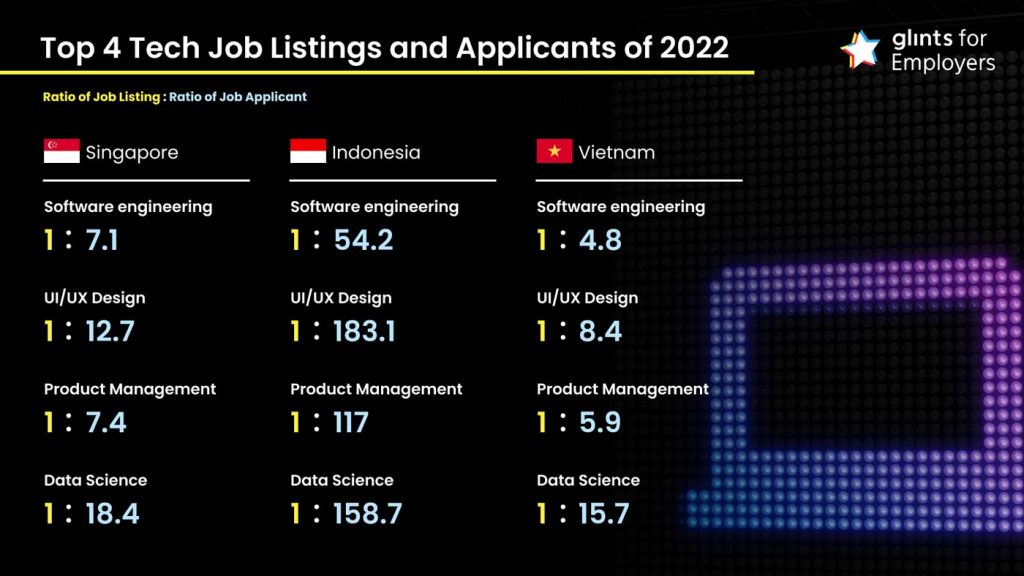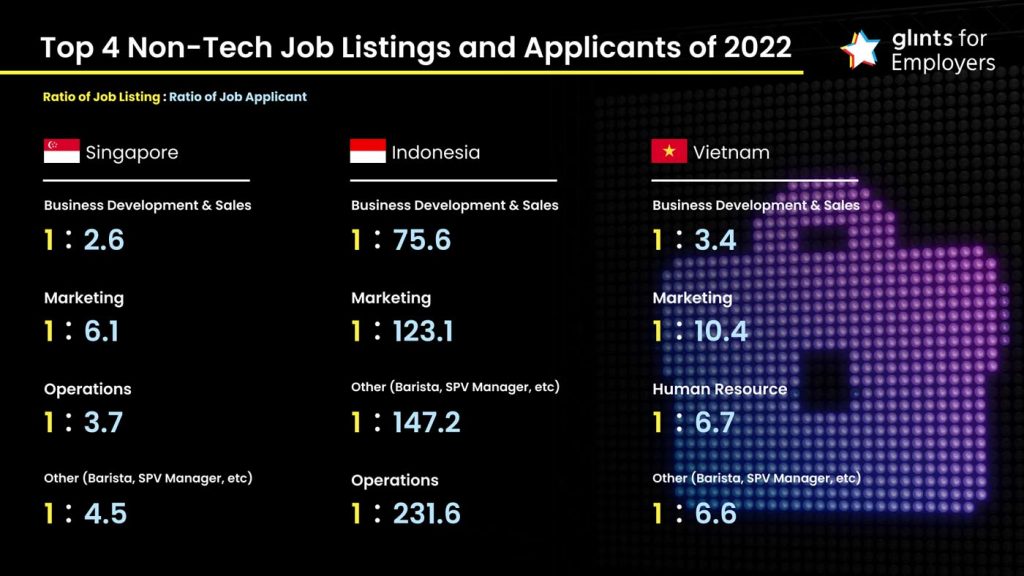SEA hiring forecast 2023: Software Engineering and Business Development roles to remain most in demand


The current economic downturn and this year’s inflation slump have led to mass layoffs across many tech firms. Companies like Meta and Twitter have already retrenched thousands of employees over the last month. Shopee, a Singapore-based online marketplace, has held three rounds of retrenchments since mid-2022.
Despite the mass layoffs, there is a silver lining in between. The pool of skilled tech talent looking for jobs will increase. This might be a boon for non-traditional tech employers who want to further their companies’ digitalization capabilities.
Small businesses such as SMEs and startups, who previously might not have had the ability to fill these roles a few months back, will also benefit from this; bearing in mind if they are in good financial standing.
This is even more promising for employers in Singapore where skilled tech talent is sorely needed. The island nation is home to the headquarters of many tech giants, such as Grab and Razer; which increases competition in an already shrinking talent pool.
Because of this local talent shortage, many companies have looked beyond borders — at neighboring countries such as Indonesia and Vietnam — to hire talent to great effect. It helps them to be cost-efficient while having access to a wider pool of diverse talent.
To understand current hiring trends, we have produced insights into the talent supply and demand in Southeast Asia (SEA) from data collected throughout 2022, focusing on Singapore, Vietnam, and Indonesia. These markets tend to be centers for key business activity, which translates to hiring interest growing exponentially.
We hope that our findings will help employers to be aware of the current tech climate and be ready for the coming year ahead.
Table of Contents
Toggle
In 2022, there were over 19,000 job postings for Software Engineering roles, placing it as the most in-demand role that employers are looking to fill in SEA. The number of job postings for this role is more than twice of the next popular role (UI/UX Design).
Job listings for Product Management and Data Science roles are significantly lower at just over 3,000 and 2,000 respectively. As for job applications in SEA, there were over 655,000 talent that applied for Software Engineering roles and over 848,000 for UI/UX Design roles.
As to why there is such a huge demand despite the current climate, Glints CTO Seah Ying Cong explains that Software Engineers are vital in building up tech companies’ long-term assets. “Even with growth slowdowns and the layoffs, I have anecdotally noticed that software engineers are one of the last few functions to be impacted,” says Seah.
He added that such investments are needed in spite of short-term market fluctuations. Seed-to-growth stage investments are still steadily rising in SEA and that might be in part what’s driving the demand.
On the other hand, UI/UX Design, another popular function, is crucial for an organization’s digitalization process. These designers are responsible for the user interface and user experience of apps and websites among others.
In 2022, there were over 19,000 job postings for Software Engineering roles, placing it as the most in-demand role that employers are looking to fill in SEA. The number of job postings for this role is more than twice of the next popular role (UI/UX Design).
Job listings for Product Management and Data Science roles are significantly lower at just over 3,000 and 2,000 respectively. As for job applications in SEA, there were over 655,000 talent that applied for Software Engineering roles and over 848,000 for UI/UX Design roles.
Like what you see? Subscribe to our newsletter to receive all our latest news and offers delivered right to your desk.
As to why there is such a huge demand despite the current climate, Seah Ying explains that Software Engineers are vital in building up tech companies’ long-term assets. “Even with growth slowdowns and the layoffs, I have anecdotally noticed that software engineers are one of the last few functions to be impacted.”
He added that such investments are needed in spite of short-term market fluctuations. Seed-to-growth stage investments are still steadily rising in SEA and that might be in part what’s driving the demand.
On the other hand, UI/UX Design, another popular function, is crucial for an organization’s digitalization process. These designers are responsible for the user interface and user experience of apps and websites among others.

In SEA, there is a high demand for employers looking for talent in Business Development & Sales, at over 28,000 postings, and Marketing, at over 24,000 postings. There are over a million talent applications for both Business Development & Sales and Marketing roles.
This suggests that talent supply is far greater than demand, especially in Indonesia and Vietnam. Employers who are hiring within these two top markets will have the benefit of being more selective when it comes to picking the right fit. On the flip side, talent will need to demonstrate special qualities or experience so that they can stand out from the vast talent pool.
Glints Recruiter Adrian Chua predicts that the trend will be similar, even beyond 2023. He elaborated that Business Development & Sales are the main “revenue generator” for every company. The role is needed to realize growth opportunities, so such roles become equal if not more urgent than tech roles in this current environment.
While our data suggests that there is an oversupply of talent, hiring tactically and cost-consciously is still advisable so that employers can acquire skilled talent with precision in a bearish environment. It’s also usually more important to focus on existing employees than attracting new ones.
Additionally, Seah recommends that companies should invest in training and developing their existing talent framework to cultivate future business needs. He elaborates that there are a lot of talent who are hungry for opportunities. However, they will need to be structured to ramp up their productivity.
For employers who want to be cost-efficient, it is recommended that they adopt a remote hiring approach to widen their sourcing pool across SEA. This will allow them access to talent from different backgrounds and cultures, diversifying their teams in the long run.
To gain a deeper understanding of hiring in various key markets across Southeast Asia, check out Glints Hiring Guide, or download a free copy of Your Ultimate Guide to Building Great Teams in Southeast Asia to learn in-depth about the strengths, traits, and cultures of these talent pools.
Build your workforce from anywhere. Start your remote hiring journey with Glints.
This article is brought to you by Glints TalentHub. Leading companies are actively building their borderless teams in Southeast Asia, Taiwan, and beyond. However, the prospect of going borderless can be daunting due to complex regulations and cultural ambiguities. With Glints TalentHub, you’ll have a dedicated team of in-market legal, HR, and talent experts by your side at every step of the way.
Glints TalentHub offers an end-to-end, tech-enabled talent solution that encompasses talent acquisition, EOR, and talent development. We empower businesses to leverage the strengths of regional talent efficiently to build high-performing, cost-efficient teams.
Schedule a no-obligation consultation with our experts to receive a tailored proposal today.
.